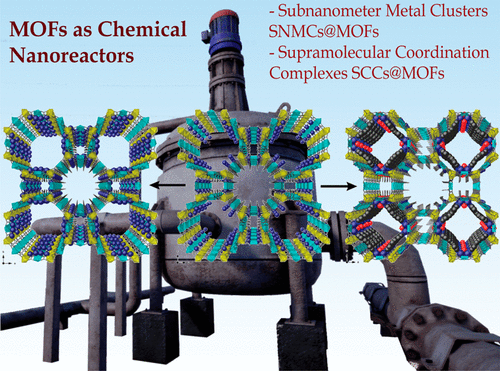当前位置:
X-MOL 学术
›
Acc. Chem. Res.
›
论文详情
Our official English website, www.x-mol.net, welcomes your feedback! (Note: you will need to create a separate account there.)
Metal-Organic Frameworks as Chemical Nanoreactors: Synthesis and Stabilization of Catalytically Active Metal Species in Confined Spaces.
Accounts of Chemical Research ( IF 18.3 ) Pub Date : 2020-02-06 , DOI: 10.1021/acs.accounts.9b00609 Marta Viciano-Chumillas 1 , Marta Mon 1 , Jesus Ferrando-Soria 1 , Avelino Corma 2 , Antonio Leyva-Pérez 2 , Donatella Armentano 3 , Emilio Pardo 1
Accounts of Chemical Research ( IF 18.3 ) Pub Date : 2020-02-06 , DOI: 10.1021/acs.accounts.9b00609 Marta Viciano-Chumillas 1 , Marta Mon 1 , Jesus Ferrando-Soria 1 , Avelino Corma 2 , Antonio Leyva-Pérez 2 , Donatella Armentano 3 , Emilio Pardo 1
Affiliation

|
Since the advent of the first metal-organic frameworks (MOFs), we have witnessed an explosion of captivating architectures with exciting physicochemical properties and applications in a wide range of fields. This, in part, can be understood under the light of their rich host-guest chemistry and the possibility to use single-crystal X-ray diffraction (SC-XRD) as a basic characterization tool. Moreover, chemistry on preformed MOFs, applying recent developments in template-directed synthesis and postsynthetic methodologies (PSMs), has shown to be a powerful synthetic tool to (i) tailor MOFs channels of known topology via single-crystal to single-crystal (SC-SC) processes, (ii) impart higher degrees of complexity and heterogeneity within them, and most importantly, (iii) improve their capabilities toward applications with respect to the parent MOFs. However, the unique properties of MOFs have been, somehow, limited and underestimated. This is clearly reflected on the use of MOFs as chemical nanoreactors, which has been barely uncovered. In this Account, we bring together our recent advances on the construction of MOFs with appealing properties to act as chemical nanoreactors and be used to synthesize and stabilize, within their channels, catalytically active species that otherwise could be hardly accessible. First, through two relevant examples, we present the potential of the metalloligand approach to build highly robust and crystalline oxamato- and oxamidato-MOFs with tailored channels, in terms of size, charge and functionality. These are initial requisites to have a playground where we can develop and fully take advantage of singular properties of MOFs as well as visualize/understand the processes that take place within MOFs pores and somehow make structure-functionalities correlations and develop more performant MOFs nanoreactors. Then, we describe how to exploit the unique and singular features that offer each of these MOFs confined space for (i) the incorporation and stabilization of metals salts and complexes, (ii) the in situ stepwise synthesis of subnanometric metal clusters (SNMCs), and (iii) the confined-space self-assembly of supramolecular coordination complexes (SCCs), by means of PSMs and underpinned by SC-XRD. The strategy outlined here has led to unique rewards such as the highly challenging gram-scale preparation of stable and well-defined ligand-free SNMCs, exhibiting outstanding catalytic activities, and the preparation of unique SCCs, different to those assembled in solution, with enhanced stabilities, catalytic activities, recyclabilities, and selectivities. The results presented in this Accounts are just a few recent examples, but highly encouraging, of the large potential way of MOFs acting as chemical nanoreactors. More work is needed to found the boundaries and fully understand the chemistry in the confined space. In this sense, mastering the synthetic chemistry of discrete organic molecules and inorganic complexes has basically changed our way of live. Thus, achieving the same degree of control on extended hybrid networks will open new frontiers of knowledge with unforeseen possibilities. We aim to stimulate the interest of researchers working in broadly different fields to fully unleash the host-guest chemistry in MOFs as chemical nanoreactors with exclusive functional species.
中文翻译:

金属-有机框架作为化学纳米反应器:密闭空间中催化活性金属的合成和稳定化。
自从第一个金属有机框架(MOF)出现以来,我们见证了引人入胜的具有令人激动的理化特性的建筑的爆炸式增长,并在广泛的领域中得到了应用。鉴于其丰富的客体化学性质以及使用单晶X射线衍射(SC-XRD)作为基本表征工具的可能性,可以部分地理解这一点。此外,已应用模板定向合成和后合成方法(PSM)的最新进展对预制MOF进行化学反应,是一种强大的合成工具,可以(i)通过单晶到单晶(SC)定制已知拓扑的MOF通道。 -SC)流程,(ii)在其中赋予更高程度的复杂性和异质性,最重要的是,(iii)提升其针对父MOF的应用能力。但是,MOF的独特属性在某种程度上受到限制和低估。几乎没有发现将MOF用作化学纳米反应器,这清楚地反映了这一点。在此帐户中,我们汇集了在MOF方面的最新进展,这些MOF具有吸引人的性质,可以充当化学纳米反应器,并用于在其通道内合成和稳定原本很难获得的催化活性物种。首先,通过两个相关示例,我们介绍了金属配体方法在尺寸,电荷和功能性方面构建具有定制通道的高度坚固和结晶的草酰胺-和草酰胺-MOF的潜力。这些是拥有游乐场的最初条件,我们可以在其中开发和充分利用MOF的奇异特性,以及可视化/理解MOF孔内发生的过程,并以某种方式使结构-功能关联并开发出性能更高的MOF纳米反应器。然后,我们描述如何利用独特的,独特的特征为这些MOF提供有限的空间,以便(i)金属盐和络合物的结合和稳定化;(ii)亚纳米金属簇(SNMC)的原位逐步合成, (iii)超分子配位化合物(SCC)的密闭空间自组装,通过PSM并由SC-XRD支持。此处概述的策略带来了独特的回报,例如极富挑战性的克规模的稳定且定义明确的无配体SNMC的制备,具有出色的催化活性,以及与溶液中组装的SCC不同的独特SCC的制备稳定性,催化活性,可回收性和选择性。本报告中给出的结果只是MOF用作化学纳米反应器的巨大潜力的最近的几个例子,但令人鼓舞。需要更多的工作来发现边界并充分了解密闭空间中的化学性质。从这个意义上讲,掌握离散有机分子和无机配合物的合成化学方法基本上改变了我们的生活方式。从而,在扩展的混合网络上实现相同程度的控制,将打开不可预见的知识新领域。我们旨在激发从事广泛领域工作的研究人员的兴趣,以充分发挥MOF中作为具有独特功能物种的化学纳米反应器的客体化学的作用。
更新日期:2020-02-06
中文翻译:

金属-有机框架作为化学纳米反应器:密闭空间中催化活性金属的合成和稳定化。
自从第一个金属有机框架(MOF)出现以来,我们见证了引人入胜的具有令人激动的理化特性的建筑的爆炸式增长,并在广泛的领域中得到了应用。鉴于其丰富的客体化学性质以及使用单晶X射线衍射(SC-XRD)作为基本表征工具的可能性,可以部分地理解这一点。此外,已应用模板定向合成和后合成方法(PSM)的最新进展对预制MOF进行化学反应,是一种强大的合成工具,可以(i)通过单晶到单晶(SC)定制已知拓扑的MOF通道。 -SC)流程,(ii)在其中赋予更高程度的复杂性和异质性,最重要的是,(iii)提升其针对父MOF的应用能力。但是,MOF的独特属性在某种程度上受到限制和低估。几乎没有发现将MOF用作化学纳米反应器,这清楚地反映了这一点。在此帐户中,我们汇集了在MOF方面的最新进展,这些MOF具有吸引人的性质,可以充当化学纳米反应器,并用于在其通道内合成和稳定原本很难获得的催化活性物种。首先,通过两个相关示例,我们介绍了金属配体方法在尺寸,电荷和功能性方面构建具有定制通道的高度坚固和结晶的草酰胺-和草酰胺-MOF的潜力。这些是拥有游乐场的最初条件,我们可以在其中开发和充分利用MOF的奇异特性,以及可视化/理解MOF孔内发生的过程,并以某种方式使结构-功能关联并开发出性能更高的MOF纳米反应器。然后,我们描述如何利用独特的,独特的特征为这些MOF提供有限的空间,以便(i)金属盐和络合物的结合和稳定化;(ii)亚纳米金属簇(SNMC)的原位逐步合成, (iii)超分子配位化合物(SCC)的密闭空间自组装,通过PSM并由SC-XRD支持。此处概述的策略带来了独特的回报,例如极富挑战性的克规模的稳定且定义明确的无配体SNMC的制备,具有出色的催化活性,以及与溶液中组装的SCC不同的独特SCC的制备稳定性,催化活性,可回收性和选择性。本报告中给出的结果只是MOF用作化学纳米反应器的巨大潜力的最近的几个例子,但令人鼓舞。需要更多的工作来发现边界并充分了解密闭空间中的化学性质。从这个意义上讲,掌握离散有机分子和无机配合物的合成化学方法基本上改变了我们的生活方式。从而,在扩展的混合网络上实现相同程度的控制,将打开不可预见的知识新领域。我们旨在激发从事广泛领域工作的研究人员的兴趣,以充分发挥MOF中作为具有独特功能物种的化学纳米反应器的客体化学的作用。



























 京公网安备 11010802027423号
京公网安备 11010802027423号